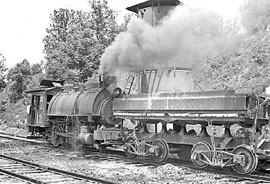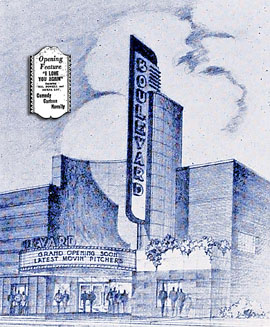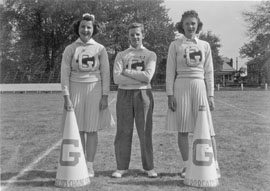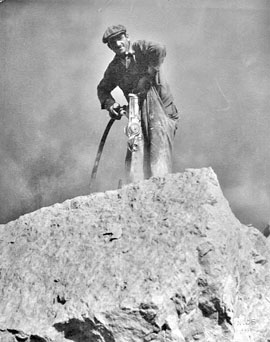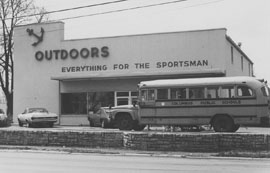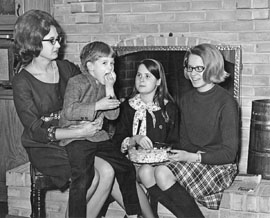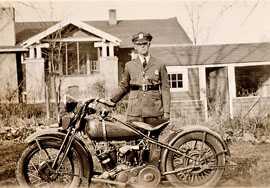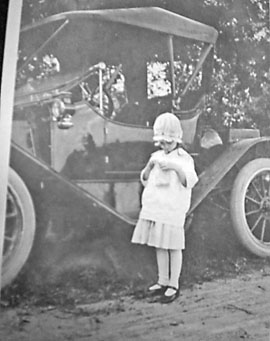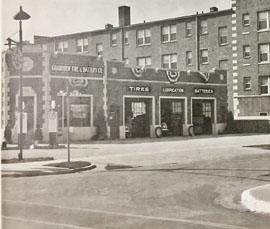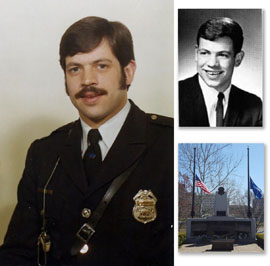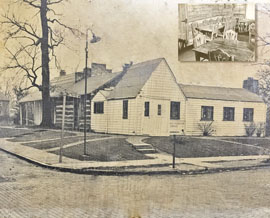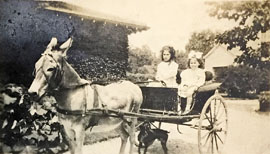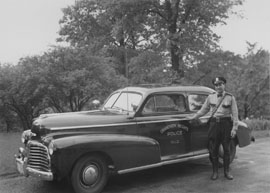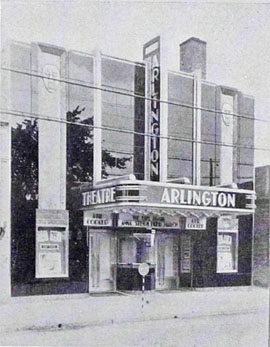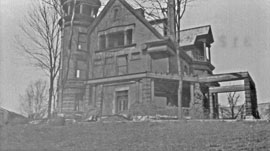The two women in this undated photograph are sitting in the rocks on the edge of the Scioto River, with the Trabue bridge in the background. Seated is Maggie Brown, who later married Lester Shrum. They lived in San Margherita, across the Scioto west of Marble Cliff. Maggie’s sister-in-law is standing. Lester and Maggie lived on Trabue Road and owned the property that includes the “Shrum Mound” on McKinley Road. A plaque near the mound was erected by the Ohio Historical Society and says “The mound is one of the last remaining earthen mounds in this area of Ohio. Built by Native American people of the Adena Culture (800 BC-100 AD). The land was deeded to the Ohio Historical Society in 1928 by the Shrum Family.” Lester Shrum died in 1943, and Maggie died in 1979 at the age of 91.
The 1940 class of Grandview Heights High School included 95 students, including the three seniors shown here, who were cheerleaders for both the 1938-39 and 1939-40 school years. They include (left to right) Olga Ashelman, Dick Armel, and Peggy Clifton. Under their spirit leadership, the Bobcat football team was very successful that year, ending the season undefeated and untied and champions of their league. On the way to the title they had 4 shutouts over Worthington, Westerville, Academy and Arlington. George "Doc" Mingle, a 1992 inductee into the Grandview Sports Hall of Fame, helped lead the team to the title.The commencement was overseen by the Acting Principal Dwight Blauser, and Dr. J.R. Rowe, President of Otterbein, gave the graduation address.
The Grandview Heights and Marble Cliff area was the site of several stone quarries that were operational from the mid-1800s. The product of the quarries was not marble, as the name of the adjacent community might suggest, but was primarily Monroe and Columbus limestone. The Marble Cliff Quarry was the largest of the quarries, providing limestone for roadbeds, furnaces, walls, and buildings. The area around the quarries developed due to large numbers of Italian immigrants brought in by Silvio Casparis who immigrated from Italy. He organized the Casparis Stone Company, which merged with several others to form the 800+ acre Marble Cliff Quarry. This photo shows a quarry worker using a jackhammer to break up the stone so that it could be mined and shipped. It was dangerous work, and many men were killed in accidents involving falls, explosions, and fires.
This 1961 photo shows the children playing in an early November snowstorm in the front yard of the Grandview home of David and Cleo Backus. Cleo Backus related in an interview in 2013, on her 100th birthday, that she bought the home at 1356 Elmwood in 1953. She was expecting their third child and wanted a home in a small town like her hometown of Croton, so one day she called a realtor who took her and her other two children to look at the home in Grandview. She liked it, so she paid earnest money, and called her husband to tell him that she had bought a house. He drove by on his way home from work to look at it, and it remained their home for the next 60 years. David died in 1994, and Cleo lived in the home until moving to the Dublin Retirement Village. The 1937 college graduate enlisted in the Navy in 1943, and served until the end of the war. She traveled on an Honor Flight to Washington in 2013 to visit Arlington National Cemetery, the WWII Memorial, and the Air Force Museum.
The Outdoors Store opened in Grandview Heights in the Masons Building at the northwest corner of First and Grandview. The owner, “RB” Barden, was an OSU professor with a great deal of personal interest in boating and outdoor activities. He lived on Dublin Road just east of Grandview Avenue, where he maintained a boat motor repair shop before opening his business. The store outgrew the space on First Avenue, so in 1955 it was moved to a building on the property next to the Barden’s home. In 1972 a fire completely destroyed the building, so it was rebuilt and housed the business until it closed in 1982. Barden retired and sold the business to Patrick Mangini and several partners. Mangini's son Rick was quoted in a recent interview that the Outdoors Store philosophy always was, "Sell the best possible products, at the best possible price, with the best possible service and expertise." This photo shows the store on Dublin Road in the mid-1960s, with a vintage Columbus Public Schools bus parked in front.
Robert G. Jones served in the Ohio House of Representatives until his death. In 1969 his widow, Doris Jones, was appointed to replace him, even though she had not served in an elected capacity before. The following year she ran for office and was elected to the General Assembly, where she served on the Commerce and Labor Committee and the Health, Education and Welfare Committee. Mrs. Jones is shown here with her children Lance, Lydia and Grace Ann (shown here, left to right) at their home in Grandview Heights. She also was a member of the Grandview PTA and several civic organizations. This photo is from the Columbus Citizen Journal Collection at the Grandview Heights Public Library.
The residence at 1122 Fairview Avenue was featured in the Grandview Heights/Marble Cliff Historical Society Home Tour this year. The home was designed by architect John Upton Gribben as his own residence. One of the features on the property was a pair of cisterns just off of the back of the house, that collected rainwater for reuse. An innovative ventilating cover for these cisterns was patented by Gribben and Max Mohr, the drawing of which (shown here) was framed and displayed on the wall by the current owners. The patent description (included on the GH/MCHS website) states that the innovation was located above ground and exposed to the atmosphere, and was designed “… to prevent danger of dislodgment of the ventilating cover and the exposure of the opening of the cistern.” It went on to say that it could accommodate a screen “to prevent access of dirt, twigs, leaves, insects, or small animals, rats and mice for example, to the cistern.”
This aerial image is looking northeast from the corner of Grandview Avenue (bottom) and McKinley Road (diagonal center). In the center of the image is the Toledo & Central Ohio Railroad roundhouse, located at the far end of the former Columbus West Yard. Built in 1918, it was a revolutionary design for railroad car and locomotive maintenance and repair. The facility included the roundhouse, a shop building, power plant, coal and oil buildings, cinder conveyors, and a 70,000 gallon water tank for supplying the steam engines. The turntable was 100 feet in diameter, with two tracks leading into it and two tracks leading out, on a heavy duty electric tractor that could orient a locomotive to one of the 20 stalls. The building was built with reinforced concrete and brick, with lots of windows for natural light. The walls were designed so that if an out of control train hit them, only the back wall of the stall would collapse, leaving the rest of the stall intact. The Grandview Avenue bridge crosses the Scioto River where the current overpass at 670 is located. The West Yard train control tower is seen at the upper right of the photo.
The Livingston Seed Company was established in central Ohio as one of the first and most prolific tomato seed hybrid providers in the country. Founded as A.W. Livingston’s Sons by Alexander Livingston in 1850, they branched out to Iowa, with his son Josiah taking the helm of the Iowa operation. In 1898, it was renamed Livingston Seed Co. and Josiah moved back to Ohio. He and his wife Merinda bought a home in Grandview on the northeast corner of First at Wyandotte. Their son Robert, GHS class of 1920 and an early member of the Brotherhood of the Rook, married Ella McCracken (also class of 1920) and settled next door at 1286 Wyandotte Rd. According to Robert’s granddaughter Melissa, he was not at all interested in the seed company business, and after spending time in the military, Robert (“Rancho” as he was known in school), joined the Grandview Fire Department in 1937. He soon moved to the Police Department, where he became known for his jodphurs worn when riding his Harley Davidson police motorcycle (shown here, with the house at 1296 Wyandotte in the background). He became Chief of Police in 1943, and was further recognizable for his trademark white Stetson hat. Survived by his wife Ella, son Robert and daughter Barb (DeLong). Chief Livingston died in 1958.
Lola Celli migrated to America in 1930 from Italy with her parents Michele and Ida, and brother Felice. Four years later they moved into a home at 1783 West Third Avenue in Grandview, between Westwood and Glenn. Lola excelled at Grandview High School, graduating near the top of her class in 1941. After graduation from Ohio State, the multi-lingual Lola took a job teaching Home Economics at West Mansfield High School. She often traveled by train back to her family’s home in Grandview, and in late February, 1946, she did so. On Saturday the 23rd, she left to take the 1st Avenue bus to a store in downtown Columbus. She was not seen again. Lola often wore her favorite red shoes to classes in Mansfield, and she had them on that day. A motorcyclist on Olentangy River Road near West North Broadway told police that he saw a red shoe fly out of a passing coupe in which a man and woman were arguing. Another motorist confirmed the red shoe, giving this missing person case the “Red Shoe Mystery” description. Many leads were followed in the case, but most turned out to be false leads. Areas around Grandview were searched several times, in one sweep by over a hundred high school students from Grandview and Arlington, but no significant evidence has been found. Grandview police continue to treat the case as an open case.
Ruth Weinman was born in Columbus in 1907. Her father was William Weinman, owner of the Weinman Pump Manufacturing Company, and her mother was Henrietta Heinmiller Weinman. Ruth lived with her parents on King Avenue until 1914, when the Weinmans hired Columbus architect Frank Packard to build a home at 1445 Central (Roxbury Road) in Marble Cliff on lot #9 of the original 1889 plat of Arlington Place. Packard was a protege of Ruth’s uncle, architect J. Upton Gribben, who lived on Fairview in Grandview. After graduating from Columbus School for Girls in 1925, Ruth studied sociology at Ohio State University, graduating in 1929. She married L. Kermit Herndon, then an assistant professor at Ohio State, and who later took over the pump company when Mr. Weinman died in 1950. Ruth was an active horseback rider, often riding with her neighbor Ruth Casparis. She was a member of the River Ridge Riding and Polo Club, which operated out of stables on the Lane Farm on Henderson Road in Upper Arlington. She is shown in this early photograph next to her father’s Franklin Roadster, c1912.
In 1924 the newly organized Grandview Heights Fire Department had become Franklin County's second (after Columbus) fire department to purchase a motorized fire fighting apparatus. It was August 8 when the newly acquired Seagrave Engine No.1 pumped its first water at a fire scene, a grass fire near Goodale and Northwest Boulevard Avenues. This photograph, provided by Melissa Overly of Granville, shows the Grandview Heights Fire Department's new 1936 Seagraves fire truck, which would replace the 1924 Seagrave Suburbanite as Engine #1. The original Grandview Heights municipal building was built in 1924 as a firehouse and city hall. A 1936 addition shown here added more bays to the rear of the original structure. The fire department also had one of the first fully-equipped emergency squads, which was donated by the Northwest Kiwanis Club in 1963. In 1973 they added coronary equipment to become a complete paramedic emergency response team.
This photo shows the Sohio station at the corner of Third and Grandview, also known as the Grandview Tire and Battery Co. The building was razed in late 2006 to build the Heights of Grandview condominiums. Sohio, or Standard Oil of Ohio, the original Standard Oil company founded by John D. Rockefeller, was one of the successor companies to Standard Oil after the antitrust breakup in 1911. Starting around 1920, there were several Sohio stations established in Grandview, including this one. Others included West Third and Northwest Blvd (until recently it was a used car lot, after the station closed because of a gas leak in the underground tanks), West Fifh and Cambridge (currently the Cambridge Tea House), and West First and Oakland (currently the site of La Tavola). Texaco had a station at First and Oxley (now a physicians office), and Pure Oil (later Union Oil) operated a station at Fifth and Northwest (currently a Verizon Store, next to the car wash) and one at Fifth and Glenn (currently Valentinos Auto Repair). Other auto repair shops were located around Grandview, including where Grandview Center currently resides, where Third and Hollywood restaurant is, on Fifth near Westwood (currently a bank), and on Third and Westwood (near the CIC building).
Big Bear Stores was founded in November 1933 by Wayne E. Brown of Columbus. The first Big Bear Store opened on February 15, 1934 on West Lane Avenue adjacent to the Ohio State University campus, in what was once a dance hall, a roller skating rink and a ring for horse shows. This opening marked the beginning of self-service super-marketing in the Midwest. The store was the first supermarket in the country to use cashier-operated motorized conveyor belts, and developed their own line of trading stamps, the familiar orange and blue "Buckeye" stamps (inset.) The headquarters and main warehouses were located at 770 Goodale Blvd. in Grandview. In 1954, Big Bear purchased Harts discount stores, and the company drew upon the Harts merchandise to increase the mix of non-grocery items in the Big Bear stores. The Buckeye stamps could be redeemed for this merchandise or for cash discounts. Big Bear was bought out in April 1989 by large supermarket holding company Penn Traffic, which owned several regional chains. Big Bear’s demise was finalized in 2004 when the last Big Bear store closed its doors, following Penn Traffic's second Chapter 11 bankruptcy in a decade, and the headquarters and warehouses between Goodale and Third Avenue were vacated. It is now the site of the Grandview Yard.
Note: Engine #2 of the GHFD was identified as a 1941 Seagraves in a previous Moment in Time. It is a 1936 Seagraves. We apologize for the error.
Officer Tom Hayes of the Columbus Police Department died in 2011 of injuries suffered when he was shot in the line of duty on December 18, 1979. Tom graduated in 1967 from Grandview Heights High School, and lived on Village Court in Marble Cliff. From 1968 to 1971, Officer Hayes served as an MP in the U.S. Army, and on his return joined the Columbus Police Force. On December 18, 1979, he responded to a convenience store after receiving reports of a disturbance by the two teenagers. As he attempted to arrest them, a scuffle ensued and one of the teens pulled out a handgun and shot him in the back. The gunshot paralyzed him below the waist. In 1986, he was hired as a civilian sketch artist for the Police Division, and he served in that capacity until 1997. Hayes designed and created the Ohio Division of Police Memorial, which was dedicated in 2000. The monument features a bronze Columbus Division of Police badge with a black mourning band atop a gray granite pillar (bottom right.) The names of 52 fallen officers are inscribed on black granite panels. His was added in 2011. He designed Christmas cards for Easter Seals, badges for the Shamrock Club, patches for the Columbus Emerald Society and the Columbus Police Honor Guard. Tom was the co-founder and first president of the Columbus Emerald Society, an organization of Central Ohio Police Officers and Firefighters of Irish descent.
In 1932 the northeast corner of Grandview Avenue at Fifth Avenue was a miniature golf course, built with cinder fairways. Stew Harrison was 34 when he bought the golf course and erected a 12'x12' building (the white section with the steeply sloped roof shown in this early 1950s photo), which he called the Hamburger Construction Company. With his two-burner hot plate, he began making 4" hamburgers which he sold for 10 cents. Over the next 24 years he expanded the small building 4 times, adding a log structure (the inset shows tables in that section of the building), an extension to the east, and an added room to the north. He then renamed the business Stew Harrison's. In 1956 he tore down all but 3 rooms and created a dining room, and by 1981 had 25 employees serving over 400 meals a day. The restaurant closed in 1984, and the building was demolished to make way for what has been a string of fast food restaurants and bars (the Winking Lizard is the latest business located on the site.) A tradition in the restaurant was to carve initials, devotions, and other messages in the wood paneling and table tops. Many of these panels were preserved, and the Historical Society put several on display in 2014.
Jessie and Betty Merkle are shown with their donkey-powered carriage outside of their home in Marble Cliff in 1912. The two girls were children of William J. and Ada Boyle Merkle, who were residents in the former Our Lady of Victory convent house at 1539 Roxbury. William Merkle, who with Ada had 4 other children, was the owner of a series of Merkle's dining rooms (founded at the Union Station in Columbus by his father Peter) which operated in railroad terminals throughout the midwest. Peter Merkle died in 1913 from injuries suffered when he was run over by a street car in downtown Columbus. The Marble Cliff house was rebuilt c1900 by Sylvio Casparis on the site of his original home, which was built in 1895 and burned down in 1899. After building a new home (the Casparis “Castle”) down the street in 1908, Casparis sold it to Harry Olmsted, President of the Equitable Coal Company, who lived there for two years before selling it to the Merkles. They lived in the home until 1922 when it was sold to the diocese. It was torn down in 2004.
Patrolman R.A. Bowshier of the Grandview Heights Police Department is shown in this May, 1943 photo next to squad car #2, a new Chevrolet sedan. All American automakers halted production at the end of 1942 for the war effort, so this could be a 1942 model or one of the few manufactured in 1943 for military or public safety purposes. Most of those were assembled from parts made in 1942 or earlier, but tagged as 1943 vehicles. Patrolman Bowshier was reprimanded in 1949 for an incident in Asheville near Circleville by the mayor of Grandview Heights. According to the Circleville Herald and the Delphos Herald newspapers, Bowshier stopped his car on a rural road, shot a chicken with a silencer equipped gun, pulled off its head and threw it into the car before driving away. He was traced by the license plate obtained by the owner of the chicken who witnessed the event. The 19-year veteran patrolman and Pickaway County native was fined $50 in court but was later suspended by the Grandview mayor.
The Arlington Theater, located at 1800 West Fifth near Grandview Heights, was opened June 1, 1935, by theater owner Clarence MacDonald. (The first feature was West Point of the Air, starring Wallace Beery, Robert Young, Maureen O'Sullivan and Rosalind Russell.) The Arlington was the first theater designed and built by the F&Y Building Service, a firm that had also built the Westmont Theater, the Fifth Avenue Theater, the Cleve, and the Indianola Theater. The glass and stainless steel theater was air-conditioned, and used the new RCA High Fidelity Sound System that had recently been invented. MacDonald died in 1940, but his wife Marie continued to operate the theater until 1944, when all of the MacDonald theaters were purchased by Leo Yassenoff. He renamed the group the Academy Theaters. Some records indicate that a new theater at Lane Avenue Shopping Center, the Lane Theater, opened in 1948 and had a significant negative impact on the ticket sales at the Arlington, and it closed its doors in 1950, although Yassenoff retained ownership of the building. The Holy Trinity Lutheran Church used the theater for its services, and the Junior Achievement of Central Ohio organization bought the building in 1969. In 1984, a group called the Society to Preserve the Arlington Theater launched an $800,000 fundraising campaign to buy and restore the Arlington Theater. They were unsuccessful, and the art deco style building was purchased in 1992 by Horizons Video and Film to house their production facilities. They sold the building in 2001 when they moved to the former Albert DeSantis mansion on Riverside Drive at Henderson Road.
The mansion of George and Alice Urlin was built on the hill overlooking the confluence of the Scioto and Olentangy Rivers in 1890. George, one of the earliest residents of what is now Grandview Heights, was an influential businessman and entrepreneur in Columbus at the turn of the century, and was responsible for the platting and development of Grandview Heights. Urlin and his wife Alice were active in the burgeoning local real estate market. Their Suburban Real Estate Company owned three separate Grandview Heights subdivisions including a huge amount of land stretching from Fifth Avenue South to Dublin Road. In addition to donating the land for the library in 1936, the Brotherhood of the Rooks home, and McKinley Field, they also provided the influence for the naming of the city. A 1994 residential planning handbook stated that builders in the Urlin Terrace Subdivision were not allowed to build their home closer to the street than his home was. The mansion was a landmark in the community, visible from afar sitting high on the hill. An image of the home is included as the logo of the Grandview Heights/Marble Cliff Historical Society. Urlin died in 1942, and after remaining empty for several years, the house was torn down (this photo shows the home just before demolition.) The property was later acquired for the development of the Summit Chase residential tower in 1965, which still uses the original Urlin driveway.
Samuel Coate Jones was born in Miami County in 1854, and worked his father’s farm until he enrolled at Antioch College. After moving to the University of Michigan to get his engineering degree, he was instrumental in the design of the narrow gauge railroad line between Toledo and Dayton, and later served as the Dayton, Covington, & Toledo Railroad’s attorney until joining the Pennsylvania Railroad. He continued to study law, and became Miami County’s prosecuting attorney and mayor of West Milton. After his wife died, he and his four children moved to Columbus in 1891. He served on the Columbus City Council and became a professor of law at Ohio State. When Grandview became a city in 1906, he was tapped in a special election to serve as its first mayor, making $75 per year. He was reelected in 1907, and served until 1909 when he was replaced by his OSU faculty colleague William Herbert Page. Jones was active in Ohio’s Republican Party, and also served as the president of the state’s Prosecuting Attorneys’ Association.

